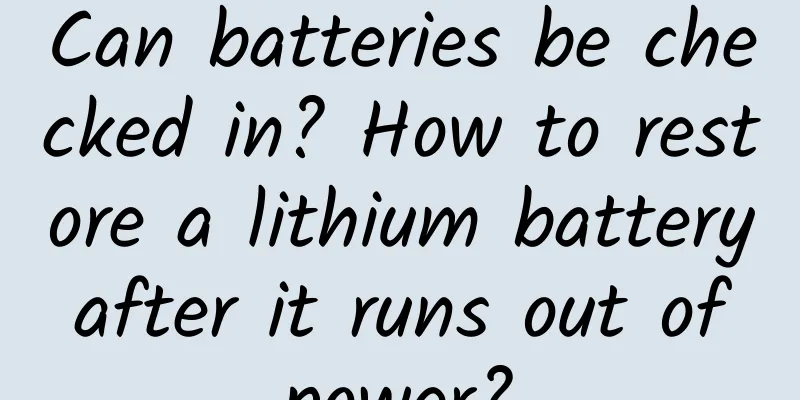Can batteries be checked in? How to restore a lithium battery after it runs out of power?

|
In our daily life, we often need to use lithium batteries. Lithium batteries refer to batteries that contain lithium in the electrochemical system. Lithium batteries can be roughly divided into two categories, lithium metal batteries and lithium ion batteries. Lithium metal batteries generally use manganese dioxide as the positive electrode material, metallic lithium or its alloy metal as the negative electrode material, and use non-aqueous electrolyte solutions. What should we do if the lithium battery is depleted after a long period of use? The following is a detailed sharing for you. Contents of this article 1. Can batteries be checked in? 2. How to restore the lithium battery when it runs out of power 3. Is it okay if the lithium battery is exposed to rain? 1Can batteries be checked in?When flying, dry batteries can be checked in, but lithium batteries cannot be checked in. Lithium batteries refer to batteries that contain lithium in the electrochemical system. If they are checked in luggage, they may be squeezed or collided during transportation, which may cause the lithium batteries to spontaneously combust, threatening flight safety. In addition to lithium batteries, deterrent devices, firearms, police equipment, controlled knives, flammable and explosive items, poisonous substances, etc. cannot be checked in. Although lithium batteries cannot be checked in, they can be carried on board, but there is a limit on the number. Generally, you can carry on board laptops, mobile phones, cameras and other electronic devices containing lithium batteries of no more than 100Wh and spare batteries in your hand luggage. Passengers may carry on board electronic devices containing lithium batteries exceeding 100Wh but not exceeding 160Wh if approved by the airline. In addition, no more than two such spare lithium batteries may be carried. 2How to restore lithium battery powerMethod 1: Overvoltage method. Try double or triple the voltage to reactivate the device. Method 2: Wipe method. Use a clean eraser to gently wipe the metal contact surface between the battery and the device. Use an eraser to remove the oxide layer on the surface, so that the battery and the device have good contact. Lithium batteries lose points due to long-term use. If a lithium battery pack is damaged, it needs to be repaired by the manufacturer. Do-it-yourself or ordinary electric vehicle repair shops cannot solve the problem. Lithium battery chargers have strict usage restrictions. Even if the batteries are from different manufacturers and have the same voltage, they cannot be used together. If other chargers are used, the battery may run out of power. Short driving distance, frequent ignition, problems with the electronic circuit, engine failure to charge, battery failure, and electrical appliances not turned off after locking the vehicle may all cause the battery to run low. 3Is it okay if the lithium battery is exposed to rain?Lithium batteries are fine if they are exposed to rain but no water has entered them. However, if they bulge, it means water has entered them and they cannot be used anymore. Lithium batteries are a type of battery that uses lithium metal or lithium alloy as the positive/negative electrode material and a non-aqueous electrolyte solution. Lithium batteries can be roughly divided into two categories, lithium metal batteries and lithium ion batteries. Lithium metal batteries generally use manganese dioxide as the positive electrode material, metallic lithium or its alloy metal as the negative electrode material, and use a non-aqueous electrolyte solution. Lithium-ion batteries are generally batteries that use lithium alloy metal oxide as the positive electrode material, graphite as the negative electrode material, and a non-aqueous electrolyte. Lithium batteries were first used in cardiac pacemakers. The advantages of lithium batteries such as extremely low self-discharge rate and gentle discharge voltage enable pacemakers implanted in the human body to operate for a long time without recharging. |
<<: Do batteries have a shelf life? How to dispose of batteries?
>>: How to extend the life of mobile phone batteries? Apple battery free replacement conditions
Recommend
What is the reason for pregnant women's bulging belly
Pregnant women will encounter some problems durin...
Can I change the place where I get the HPV vaccine?
The hpv vaccine is mainly a vaccine for women, an...
What can pregnant women eat to relieve back pain?
During pregnancy, pregnant women's bodies gra...
Why do girls have nipple pain?
Many female friends have experienced nipple pain,...
What is the normal index of transaminase? What is the disease if the transaminase is high? Is it serious?
Checking transaminase is the most common item in ...
What are the diseases and pests of rapeseed seedlings? How to prevent and control rapeseed seedling pests
Rapeseed is a common vegetable in life. It is dee...
What kind of flour is Cross-Bridge Rice Noodles made of? How to make authentic Yunnan rice noodles
Cross-bridge rice noodles are a specialty food in...
What to do if a woman has hydronephrosis
Female patients with hydronephrosis must be very ...
My period is delayed for two months without pregnancy
It is normal for women to have their periods ever...
Can I have sex the day before my period?
During menstruation, women's body resistance ...
Can women have sex if they have urinary tract infection?
Sexual life is very normal for adults, but for pe...
Annoying cheilitis
Every time the seasons change, many people will f...
[Medical Q&A] How to detect early signs of leukemia?
Author: Yang Lihua, deputy chief physician, Zhuji...
Deep feelings, swallowing it all? This kind of feelings is very harmful to your health!
Wine culture is a tradition in China since ancien...
Honey and "it" can quickly remove freckles, witness the miracle in 20 minutes
Summer is coming, and many women have various min...









